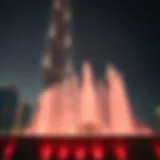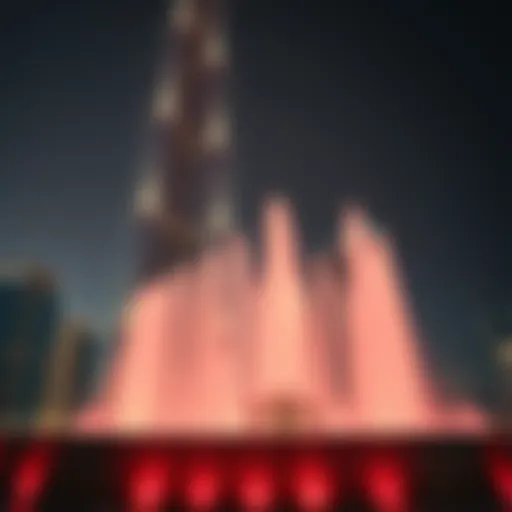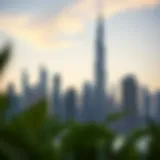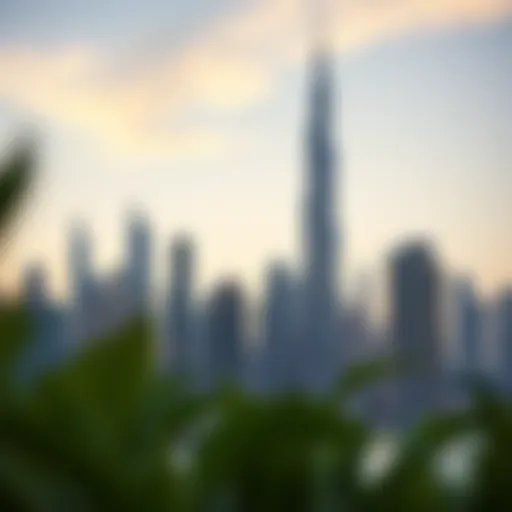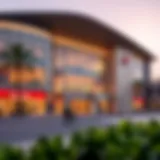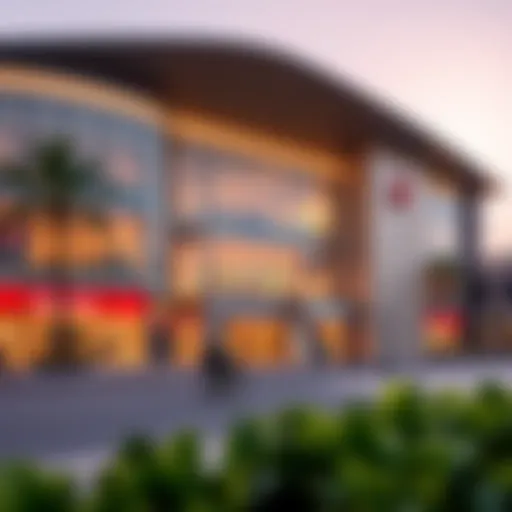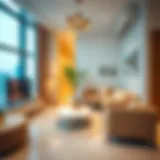Exploring Dubai's Iconic Buildings and Their Impact
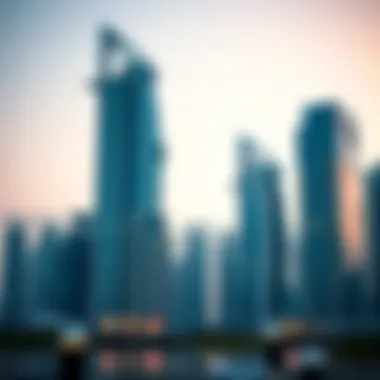

Intro
Dubai, a city that rides the wave of innovation and luxury, stands as a testament to human ambition and architectural creativity. The skyline tells a story of resilience and bold vision. Each building serves not merely as a structure but as a symbol—reflecting the aspirations of a nation on the rise. From the record-breaking Burj Khalifa, the tallest building in the world, to the Dubai Frame, a striking piece of architecture that offers breathtaking views, these landmarks have become integral to the city's identity.
This article embarks on a journey through Dubai's most renowned architectural feats, examining their cultural significance, functionality, and contributions to the urban landscape. We will ultimately break down how these monumental designs influence real estate dynamics, attract tourism, and enhance the city’s international reputation.
As we traverse through the discussions on market trends, influences on real estate and essential buying or renting guides, we'll uncover the multidimensional role these architectural landmarks play not just in shaping Dubai’s image but also in carving opportunities for investors, architects, and the everyday buyer.
With a focus on the implications of construction choices and market reactions, our exploration will be thorough, offering deep insights that transcend basic surface understanding.
Foreword to Dubai's Architectural Landscape
Dubai’s architectural landscape offers a fascinating tapestry of history, culture, and innovation. Nestled in the heart of the UAE, the city has transformed into a global symbol of luxury and modernity, showcasing a skyline that rivals the great metropolises of the world. Exploring this architectural marvel is not just about admiring the towering buildings; it’s about understanding the stories they tell, the challenges they overcame, and the vision behind each design.
One essential aspect of Dubai’s growth is how its architecture reflects a unique blend of tradition and futurism. Each structure, whether it be the swooping curves of the Burj Al Arab or the minimalist lines of the Museum of the Future, serves as a testament to the city’s ambition. Visitors and residents alike are offered an invitation to explore not only what these buildings do but what they represent in the grand scheme of urban evolution.
In the realm of real estate and urban development, Dubai’s landmarks play a pivotal role. The skyline is not merely for aesthetic pleasure; it attracts investment, drives tourism, and boosts the local economy. These towering constructions symbolize a city that is constantly striving for greatness, echoing the UAE's aspirations on the global stage.
Moreover, as Dubai faces increasing challenges such as regulatory demands and environmental concerns, the importance of sustainable architectural practices comes into sharp focus. As we delve into the specifics of notable buildings and their impact, we see how the architectural landscape becomes a mirror reflecting both local identity and international influences.
"Architecture is a visual art, and the buildings speak for themselves." – Julia Morgan
Keeping these themes in mind, the subsequent sections of this article will explore the evolution of Dubai's skyline and the central role real estate plays in the city’s development, setting the stage for a deep dive into each landmark's significance and contribution to Dubai's identity.
Burj Khalifa: The Pinnacle of Innovation
The Burj Khalifa stands not just as a skyscraper but as a beacon of innovation and ambition that captures the spirit of Dubai. This structure marks a significant milestone in architectural history, representing not only the heights of design and engineering but also a unique convergence of cultural storytelling and modern investment opportunities. The implications of this towering edifice extend far beyond its physical dimensions, influencing tourism, the economy, and urban development in profound ways.
Architectural Design and Features
Completed in 2010, the Burj Khalifa redefines what a skyscraper can be. At a staggering 828 meters, it holds the title of the tallest building in the world. Designed by Adrian Smith of Skidmore, Owings & Merrill, the architecture draws inspiration from traditional Islamic architecture, which can be seen in its three-tiered, spiraling form. The building’s design incorporates a series of setbacks, each smaller than the one below it, which not only contributes to its aesthetic appeal but also enhances its structural integrity against high winds.
Constructed with over 103,000 square meters of reinforced concrete, the Burj Khalifa includes a mixture of commercial, residential, and hotel space. Importantly, the building showcases advanced technology such as sustainable systems for water and energy management. The exterior is clad with reflective glazing that minimizes solar gain, making it as much an environmental landmark as an architectural one.
Furthermore, each section of the building is meticulously designed to optimize views. The observation deck, located on the 148th floor, offers breathtaking panoramas of the city and beyond - a testament to how design and utility can coalesce into a singular experience.
Impact on Tourism and Economy
The Burj Khalifa isn’t just an architectural triumph; it has dramatically altered the economic landscape of Dubai. As a key focal point, it attracts millions of tourists annually.
"The Burj Khalifa has undeniably boosted Dubai’s image as a global tourist hub," says tourism expert Samir Al-Fahd.
This influx of visitors not only benefits the surrounding hotels and restaurants but also contributes significantly to the local economy through increased spending.
Several studies have shown that the presence of such a landmark increases property values in the vicinity. Businesses find their footing in close proximity to the Burj Khalifa, taking advantage of the tourist traffic. Moreover, the icon has fueled the development of the surrounding Downtown Dubai area, leading to the establishment of vibrant retail experiences and a dynamic community environment.
Explore the financial market implications at reddit.com.]
This examination illustrates that as Dubai thrives on innovation, the Burj Khalifa continues to be a pivotal element of that growth, symbolizing the limitless ambition of the city.
Burj Al Arab: A Symbol of Luxury
The Burj Al Arab stands tall as a beacon of luxury and sophistication in Dubai. Often dubbed the world’s only seven-star hotel, its architecture, service, and prestige are the stuff of legends. This building isn’t merely a place to stay; it’s an experience carefully crafted to embody opulence. Understanding its significance is crucial for anyone interested in Dubai's architectural story, especially for investors and designers who seek to grasp the fusion of aesthetics and commercial potential.
Design Aesthetic and Iconic Status
When one gazes upon the Burj Al Arab, the first striking fact is its unique sail-shaped silhouette which cuts through the skyline. Designed by the renowned architect Tom Wright, this structure redefines creativity. Its exterior is a masterpiece of contemporary architecture, characterized by curves, glass, and steel. The building’s height of 321 meters makes it not only a prominent figure in the Dubai skyline but also an architectural icon recognized worldwide.
The facade of the Burj Al Arab is clad in a double-skin glass, creating a modern yet timeless look, while its large arch gives the impression of a majestic ship in full sail. This design doesn’t simply serve aesthetic purposes; it reflects cultural nuances of both Arabic traditions and modern influences. The intricacies of Islamic patterns are woven throughout, bringing a sense of local authenticity to this global landmark.
Beyond mere appearance, Burj Al Arab embodies the aspiration of Dubai as a hub for luxury tourism. The hotel’s unique shape has made it a symbol of wealth and success, attracting countless tourists eager to explore its luxurious offerings. It’s not just a building; it’s a statement of ambition that plays a pivotal role in reinforcing Dubai’s identity as a leading luxury destination.
Exclusive Services and Amenities
What truly sets the Burj Al Arab apart is not just its breathtaking design but the unrivaled services offered within its opulent walls. This landmark features exclusive services that cater to the whims and fancies of the elite. For instance, guests can reach the hotel via a private helipad, ensuring a grand entrance. Inside, the experiences continue with a staff-to-guest ratio of 8:1, showcasing a commitment to exemplary hospitality.
Some of the most notable features include:
- Luxury Suites: Each of the hotel's 202 suites boasts lavish furnishings, with the two-bedroom royal suite costing a staggering amount per night, epitomizing the height of luxury.
- Gourmet Dining Options: The Burj Al Arab is home to a collection of world-class restaurants, including the underwater Al Mahara, offering a dining experience like no other.
- Private Beach Access & Pools: Guests can indulge in sheer leisure with exclusive access to pristine beaches and infinity pools, complete with cabanas and personal butler service.
- Wellness Facilities: The Talise Spa is a sanctuary for relaxation, offering treatments rooted in Arabian traditions, making it a luxurious retreat after a day exploring the city.
The attention to detail in services reinforces the conceptualization of the Burj Al Arab as an experience rather than merely a lodging facility. Here, visitors are enveloped in an ambiance of elegance and sophistication, ensuring their stay is nothing short of extraordinary.
"The Burj Al Arab transcends traditional luxury accommodations, becoming a living piece of art, celebrating the spirit of Dubai’s ambition."
In sum, the Burj Al Arab is a pivotal landmark that merges cutting-edge design with unparalleled service. For investors, buyers, and analysts, understanding its allure can unlock insights into the wider trends shaping Dubai’s vibrant real estate landscape.
Learn more about Burj Al Arab at Wikipedia | Explore Dubai’s luxury market at Britannica
Dubai Frame: A Gateway to the Past and Future
The Dubai Frame serves as a remarkable emblem of the city’s commitment to blending history with modernity. It isn’t just a structural marvel but stands as a bridge connecting the old and the new, providing insight into Dubai’s rapid transformation. This landmark represents how the city celebrates its rich heritage while embracing futuristic aspirations. Its unique architectural concept highlights a vision for not only tourism but also education and culture, making it an invaluable addition to Dubai’s skyline.
Architectural Concept and Structure
The architectural concept behind the Dubai Frame is nothing short of visionary. It was designed by the renowned architect Fernando Donis, who envisioned a structure that would encapsulate the essence of the city’s evolution. The Frame is 150 meters tall and 93 meters wide, resembling a colossal picture frame that actually frames each side of the skyline. One side showcases the historic heart of the city, while the other gazes into the futuristic Dubai filled with innovative skyscrapers.
- Materials: The use of a combination of steel and glass not only provides durability but also gives it a shimmering facade that reflects sunlight beautifully.
- Viewing Decks: Visitors are treated to breathtaking panoramic views from the observation deck, located at a height where they can seamlessly transition from the past to the present.
- Exhibition Spaces: Inside, the Frame houses exhibitions that elaborate on Dubai’s historical and cultural narrative, offering a rich storytelling experience.
This blend of design and function distinctly positions the Dubai Frame not merely as a tourist spot but as a piece of art that sparks curiosity about the city’s journey. The uniqueness of this structure lies in its ability to showcase contrasting eras, merging architectural aesthetics with city identity.
Cultural and Educational Significance
Beyond its awe-inspiring structure, the cultural and educational significance of the Dubai Frame cannot be overstated. It acts as an archive, a gallery, and an educational hub all rolled into one, aiming to engage visitors and locals alike. The Frame is not just about looking at Dubai’s past; it’s about understanding it.
- Learning Opportunity: The exhibitions available within the Frame explore Dubai’s transformation from a small fishing village to a thriving metropolis. This journey is critical for both expatriates and locals to appreciate their shared history.
- Cultural Exhibitions: Regular cultural events are hosted here, featuring local artists and cultural stories, fostering a sense of community and shared destiny.
- Visitor Engagement: Hundreds of thousands flock to the Frame each year, many of whom participate in workshops and guided tours, enhancing their connection to the city's narrative.
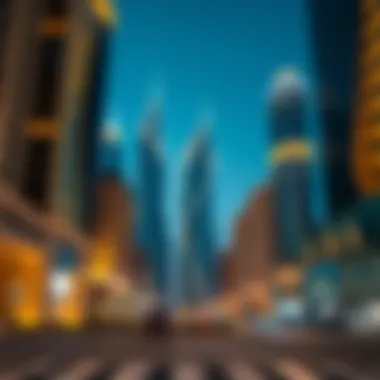

"The Dubai Frame is not just a structure; it’s a reminder of how far we’ve come and how much further we can go."
Thus, the Dubai Frame symbolically stands as a gateway—linking generations through its rich educational offerings while simultaneously setting the stage for future advancements. As such, it doesn’t just contribute to Dubai’s architectural vocabulary; it shapes the very identity of a city in constant flux.
The Palm Jumeirah: Engineering Marvel
The Palm Jumeirah stands as a testament to Dubai's ambitious vision and engineering prowess. This man-made archipelago, shaped like a palm tree, is more than just a visually stunning feature of the coastline; it embodies the evolution of construction techniques and urban planning in the region. The significance of the Palm Jumeirah lies not only in its grandeur but also in its role as a major economic driver, showcasing how innovative real estate development can transform a city’s identity.
Development and Construction Challenges
When embarking on a project of such scale, challenges were inevitable. The construction of the Palm Jumeirah presented numerous hurdles, from environmental concerns to logistical issues. The groundbreaking underwater land reclamation and the sheer volume of sand—approximately 94 million cubic meters—used to create the island were colossal tasks.
- Environmental Impact: Detractors pointed out potential harm to marine life and local ecosystems. Extensive environmental studies were conducted to mitigate any adverse effects, though concerns persist about habitat disruption.
- Logistical Coordination: Balancing the influx of materials, equipment, and skilled labor required meticulous planning. The island’s unique shape also raised specific engineering complexities, making the execution of unique designs both fascinating and daunting.
- Weather Conditions: The extreme heat and unpredictable weather in the region posed additional risks, forcing engineers to adapt their strategies and schedules frequently.
Despite these challenges, the vision for the Palm Jumeirah did not falter. Creatively overcoming these obstacles has led to innovations that set benchmarks for future projects.
Real Estate Value and Amenities
The Palm Jumeirah has redefined luxury living in Dubai. Real estate on the island commands a premium, making it one of the most sought-after locations in the world. Properties here, ranging from opulent villas to high-end apartments, not only offer stunning views but also an exclusive lifestyle.
- Luxury Residences: The architectural designs of the residences reflect high-end aesthetics with modern amenities. Each villa or apartment embodies opulence, boasting features like private pools, beach access, and breathtaking panoramas of the Arabian Gulf.
- World-Class Amenities: Residents enjoy a plethora of facilities, from top-tier gyms and spas to beach clubs and gourmet dining scenes. The island’s extensive boardwalk complements the luxurious offerings, turning everyday life into a lavish experience.
- Investment Appeal: Properties in Palm Jumeirah are seen as solid investments due to their unique location and the continuing demand for luxurious living spaces. Rental yields are also favorable, attracting both buyers and investors seeking a piece of this real estate gem.
In summary, the Palm Jumeirah is not only a feat of engineering but also a vibrant community that reflects Dubai's dynamic spirit. By overcoming development hurdles and establishing itself as a premier destination for luxury, the Palm VI inserts itself uniquely in the fabric of the city's identity.
Dubai Marina: A Testament to Urban Design
Dubai Marina is often touted as one of the most ambitious and visually stunning urban projects in the world. It embodies the essence of Dubai's rapid growth and desire for innovation in the architectural landscape. The Marina's unique blend of residential and commercial spaces makes it not just a district, but a vibrant community that showcases how urban planning can enhance livability.
Residential and Commercial Landscape
The residential offerings in Dubai Marina are as diverse as the population it serves. Towers like the Marina Pinnacle and the Princess Tower stand tall, offering stunning views of the waterfront and beyond. From luxurious penthouses to more modest apartments, there’s something for every taste and budget. Many of these units come with amenities such as swimming pools, gyms, and even private beach access, blending luxury with convenience.
On the flip side, the commercial aspect of Dubai Marina is equally impressive. With shopping malls, restaurants, and offices in close proximity, residents enjoy the ease of having everything they need within a short walk or drive. The area is also home to high-profile businesses, creating a bustling environment that attracts professionals from various fields.
The Dubai Marina is not just about high-rises; it's about creating a lifestyle that’s reflective of the city’s dynamism.
Community Features and Accessibility
A noteworthy aspect of Dubai Marina is its focus on community living and accessibility. The Marina Walk, a scenic promenade lined with cafes and entertainment options, is a favorite spot for residents and visitors alike. It encourages outdoor activity, fostering a sense of community among diverse groups.
Transport is another pillar of Dubai Marina’s design. The area is well-served by public transportation, including the Dubai Metro and various bus routes. Water taxis and ferries also provide alternative commuting options, making it easier for residents to navigate between neighborhoods.
In terms of community features, parks and recreational spaces are interspersed among the towers, adding green zones that enhance the urban atmosphere. Playgrounds, jogging paths, and fitness areas cater to families and health-conscious individuals. With such thoughtful design, Dubai Marina exemplifies how modern urban spaces can combine functionality with aesthetic appeal, offering both luxury and accessibility.
To delve deeper into the subject, you may refer to this comprehensive resource on urban planning or explore Dubai Marina's official site for community updates and events.
The Museum of the Future: A Visionary Endeavor
The Museum of the Future stands as a beacon of innovation and forward-thinking in Dubai's urban tapestry. Built to showcase cutting-edge technologies and provide insights into what lies ahead, this landmark is essential for understanding not just the architectural advancements, but also the broader aspirations of Dubai’s future. More than a simple museum, it embodies the city’s commitment to progress, creativity, and sustainability. As a key player in Dubai's cultural landscape, it encourages discussions on the implications of technology and how it will shape our world.
Innovative Design and Technology Integration
The architecture of the Museum of the Future is nothing less than remarkable. With a design that feels like it’s plucked straight from a sci-fi novel, the building features a toroidal shape, comprised of a seamless facade of stainless steel and glass. This unique design doesn’t just aim to please the eye; it also serves functional goals underlining energy efficiency and reduced environmental impact.
Traffic flow and visitor experience have been meticulously planned, incorporating smart technologies into every nook and cranny. For instance, the intelligent building management system optimizes energy use based on real-time conditions. It showcases smart lighting that adjusts automatically, ensuring sustainability without sacrificing comfort. Furthermore, augmented reality exhibits allow visitors to immerse themselves in future technologies, enhancing educational experiences through interactive engagement.
"The Museum of the Future is not just a building; it is an experience that will shape public understanding of technologies that are yet to come."
This endeavor represents a critical bridge between contemporary understanding and future possibilities, emphasizing how Dubai can lead in global innovation. The integration of such advanced technology continues to attract attention, not just as a marvel of modern architecture but also as a model for upcoming developments in smart buildings and urban environments.
Cultural and Scientific Contributions
Culturally, the Museum of the Future plays a pivotal role in enriching Dubai's identity. It acts as a platform for both local and international artists and innovators, hosting various exhibitions, workshops, and forums that delve into science and the arts.
Key features include:
- Public Programs: Engaging activities designed for all ages to understand technology's role in society.
- Collaboration with Universities: Partnering with institutions to foster academic research, showcasing scientific advancements.
- Forums on Technological Ethics: A venue for scholars and practitioners to deliberate on the moral implications surrounding future technologies.
The blend of these initiatives creates a dynamic space where cultural discourse meets scientific exploration. With the potential to impact local communities and international visitors alike, the Museum of the Future reinforces Dubai’s image as a nexus of cultural exchange and intellectual prowess.
Sustainable Building Practices in Dubai
Dubai's architectural landscape is not only a testament to human ingenuity but also a canvas for sustainable building practices that prioritize environmental stewardship alongside opulence. In a city where development seems to rise overnight, sustainability has taken center stage as a cornerstone of architectural philosophy. Investing in sustainable building practices is essential, especially when you consider that these initiatives can significantly mitigate the environmental impact of urban expansion. They are not just a trend but a necessity in our changing climate.
Emerging from this focus are various innovative approaches to construction that are changing the developmental blueprint of Dubai. Citizens and visitors alike express a growing appreciation for these efforts, and the importance of green building methods cannot be overstated. Building sustainably not only reduces waste but also promotes energy efficiency, helping to cut operational costs in the long run and align with global environmental goals.
"The future of architecture lies in its ability to adapt and integrate sustainable practices without compromising on design and functionality."
Green Architecture Examples
In Dubai, numerous structures epitomize the green architecture movement. Among the most notable is The Sustainable City, an entire community designed around sustainability principles. The development features solar panels, a bio-dome, and electric vehicle charging stations, all working cohesively to minimize the environmental footprint. This community showcases how urban life can be harmonized with nature through thoughtful design.
Another hallmark example is The Mohammed bin Rashid Al Maktoum Solar Park. Once completed, this vast project is set to be one of the largest solar parks in the world, utilizing innovative energy solutions and contributing significantly to Dubai's vision of a greener city. Additionally, the Dubai Financial Market has also incorporated green practices, including energy-efficient systems, water conservation tactics, and the use of recyclable materials.
These examples paint a vivid picture of a city that is not just building walls but also communities that respect and nurture the environment. Beyond individual buildings, the integration of green roofing and walls in various skyscrapers adds another layer of sustainability, utilizing vegetation to enhance air quality and reduce urban heat.
Impact on Real Estate Development
The movement towards sustainable construction is undeniably reshaping the real estate landscape in Dubai. As consumer awareness about environmental issues grows, a shift in demand is becoming evident. Investors and homebuyers are increasingly on the lookout for eco-friendly properties that offer not only luxury but also a commitment to sustainability. This trend prompts developers to incorporate green technology and designs to provide market-ready real estate.
Sustainable buildings, equipped with energy-efficient lighting, water-saving fixtures, and smart technology, tend to attract higher occupancy rates and command premium pricing. Additionally, many investors now recognize that sustainable practices can lead to better property valuations over time.
The emphasis on sustainability in real estate development also dovetails with legislative frameworks. The UAE government has established various initiatives and regulations, such as the Green Building Regulations, incentivizing developers to adopt sustainable practices. The stakeholders in real estate are finding that adhering to these norms not only meets regulatory demands but also enhances their reputation in an increasingly competitive market.
In summary, Dubai's dedication to sustainable building practices underscores a broader commitment to environmental responsibility. The emerging trend of green architecture is fueling the real estate sector, creating a win-win situation that draws investments while simultaneously fostering sustainable urban growth.
The Role of Landmark Buildings in Shaping Dubai's Identity
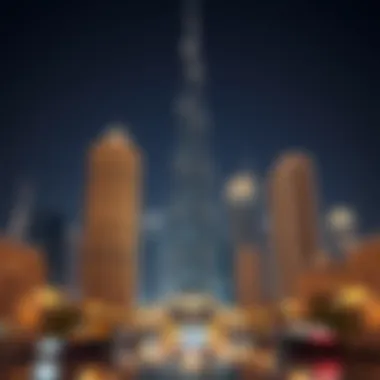

Landmark buildings play a crucial role in defining the identity of Dubai, marking its transformation from a modest trading port to a global metropolis. These architectural feats are not merely structures— they embody the aspirations, culture, and dynamism of the city. Each landmark serves as a testament to the innovative spirit of Dubai and its residents.
Underneath the sleek glass façades and towering heights, there's a narrative woven through culture, tradition, and modernity. Architects and developers collaborate to create buildings that resonate with the spirit of the times, reflecting both the deep-rooted history and the futuristic vision of Dubai. Investors, buyers, and designers alike see these landmark properties as both real estate opportunities and rich cultural dialogues.
Cultural Reflections in Architecture
The architecture of Dubai is a vibrant tapestry, stitching together its rich heritage and its outlook towards the future. From the ornate elements of traditional Arabic design seen in the Al Fahidi Historic District to the minimalist aesthetics of contemporary skyscrapers, each landmark tells a story. For instance, the Burj Khalifa is not only a testament to engineering prowess but also an acknowledgment of the Emirati culture, drawing inspiration from the desert flower Hymenocallis. This blending of cultural influences creates a sense of identity that is palpable throughout the city.
Architectural forms in Dubai symbolize the country’s ambition to be at the forefront of global cities. They challenge conventional boundaries and invite discourse around modernization while respecting tradition. The architectural designs often reflect aspirations—be it with the sweeping curves of the Burj Al Arab or the futuristic lines of the Museum of the Future. Such constructions foster a dialogue between the past and the present, allowing local inhabitants and visitors to immerse themselves in an evolving cultural landscape.
Landmarks as Branding Tools
Dubai’s landmarks are not only impressive sights; they are also integral to the city's branding strategy. The presence of structures like the Burj Khalifa and the Palm Jumeirah has elevated Dubai's status as a tourist destination, acting as magnets for global investment. They frame the city's image, driving not only tourism but also creating a unique selling proposition for potential investors.
"Landmark buildings portray a city’s promise and potential."
Real estate developers recognize the power of these buildings as branding tools. Each landmark brings with it a sense of prestige and exclusivity that can significantly enhance property values. The branding effects extend beyond mere aesthetics; they harness the allure of luxury, commentary on sustainability, and forward-thinking design, making properties adjacent or closely related to these landmarks immensely desirable.
In this way, Dubai's architecture acts as a crucial component of its overall identity— not simply delineating its skyline but also encapsulating the city's ethos, ambitions, and cultural dialogues. Both local and global audiences are left with lasting impressions shaped profoundly by these edifices.
Challenges in the Construction of Landmark Structures
Construction of landmark structures in Dubai is no small feat, laden with a myriad of challenges that stretch the abilities of architects, project managers, and builders alike. These complexities are not just hurdles; they play a critical role in defining the skyline of this global city. Addressing these challenges head-on facilitates not only the successful completion of iconic buildings but also sets a benchmark for future architectural endeavors. As such, understanding the intricacies of this process is paramount for investors, designers, and stakeholders involved in the real estate market.
Engineering and Materials Issues
One of the crown jewels of challenges faced during construction is primarily rooted in engineering and materials. For instance, the use of innovative materials designed to withstand Dubai's extreme heat and sandstorms is not merely a matter of preference but a matter of necessity. The structural integrity of a building like the Burj Khalifa demands exceptional engineering prowess. Engineers and architects often face the issue of finding new materials that are both resilient and lightweight.
For example, high-performance concrete is regularly utilized to provide strength while minimizing weight. This balancing act between durability and weight is critical, as there is often a need for taller structures to reduce the footprint and maximize land usage. Moreover, advanced engineering techniques such as BIM (Building Information Modeling) allow professionals to simulate various elements of a construction project before actual implementation, which limits the margin of error and enhances the efficiency of resource usage.
- Innovative Materials:
- High-performance concrete
- Composite materials for enhanced strength
- Insulation materials resistant to extreme temperatures
However, sourcing these materials can be just as complex. With global supply chains strained, especially during unforeseen circumstances such as pandemics, builders have encountered delays and increased costs associated with material acquisition. Each phase of a landmark’s construction must be meticulously planned, yet the volatile nature of material availability can throw a wrench into the works, leading to cascading delays downstream.
Regulatory and Environmental Factors
In addition, regulatory and environmental factors significantly influence the construction timeline and methodology. The necessity to navigate intricate regulations set forth by the local government means one must stay abreast of changes in building codes and environmental legislations. In Dubai, where architectural endeavors must complement the desert climate, adhering to stringent environmental guidelines is paramount.
The city’s government emphasizes sustainability, which often results in builders needing to modify their original plans. For instance, the implementation of green technologies may require additional layers of approvals, which can prove time-consuming.
Moreover, environmental concerns can lead to limitations on construction hours, materials, and processes that may be disruptive to local ecosystems. As a result, planners must innovate within these constraints, often using eco-friendly materials as a means to align with environmental standards and gain community support.
- Key Regulatory Considerations:
- Environmental Challenges:
- Adhering to building codes
- Obtaining environmental impact assessments
- Neighborhood approvals and public consultations
- Protecting local wildlife
- Managing the use of water and energy resources
- Minimizing waste and promoting recyclability in materials
Adhering to these regulations is not merely a formality; it can be the difference between a project’s success and its abrupt halt. By cultivating a proactive approach to navigating these challenges, investors and project managers can facilitate smoother project flows and ensure their iconic structures not only beautify the skyline but also contribute positively to Dubai’s urban landscape.
"In every challenge, there lies an opportunity for growth, innovation, and progress."
In summary, the construction of landmark buildings in Dubai is intricately tied to engineering challenges and regulatory dynamics. Understanding these factors not only ensures the physical integrity of structures but also promotes sustainable practices that respect the environment and uplift the community.
Future Landmark Developments in Dubai
As Dubai continues to redefine itself as a global hub of innovation and luxury, the future of its architectural landscape promises to be bold and adventurous. Understanding future landmark developments in this vibrant city is crucial for anyone engaged in the real estate market or interested in architectural innovation. These developments not only shape the skyline but also reflect a shift in urban living and environmental sensitivity.
The city’s real estate dynamics are intrinsically tied to its landmark buildings. They attract investments, boost tourism, and lay the groundwork for enhanced urban integration. As new projects emerge, they can potentially revamp the entire real estate sector, changing how buyers and investors approach the Dubai property market.
Upcoming Projects and Innovations
Dubai is on the verge of several ambitious projects that are set to stand as milestones in architectural creativity and sustainability. Some of the projects garnering significant attention include:
- Dubai Creek Tower: Projected to soar even higher than the Burj Khalifa, this tower aims to blend cultural heritage with modern design, becoming a key attraction and community node.
- The Loop: This mega-project will feature a 20-kilometer loop around Dubai’s most iconic landmarks creating an engaging experience for residents and tourists alike.
- Dubai Urban Tech: Aiming to amplify smart technology in buildings, this initiative combines architecture with tech, promoting energy efficiency, and smarter living options.
"The construction of Eco-City, a self-sustained community, is not just about buildings; it's a lifestyle shift towards sustainability that echoes throughout the region.”
These projects reflect an exciting trajectory in which architecture adapts to serve both the local populace and international visitors. Innovations like smart energy systems and community-centric designs are making strides toward a more harmonious urban ecosystem.
Potential Impact on Real Estate Sector
The rise of these landmark projects is poised to significantly impact the real estate sector in Dubai. Firstly, these developments can lead to:
- Increased Property Values: With landmark buildings attracting attention, surrounding areas often see an uptick in property prices.
- Tourism Boost: Iconic structures heavily influence tourism influx, which in turn increases demand for residential and commercial spaces nearby.
- Investment Opportunities: Most of these developments are likely to appeal to international investors, providing new avenues and projects for potential high returns.
However, investors and stakeholders should be aware of possible regulatory changes that might directly affect how these properties will evolve. Being in tune with the local market dynamics and emerging building trends will provide a competitive edge.
Public Perception of Iconic Buildings
Public perception of iconic buildings holds significant weight in understanding the cultural and economic landscape of a city, and in the case of Dubai, it is no different. These buildings often serve as visual representations of the city's aspirations and stature on the global stage. When pondering a city like Dubai, images of stunning architectural feats spring to mind, from the towering Burj Khalifa to the extravagance of the Burj Al Arab. Yet, perception involves more than just aesthetics; it encompasses the feelings of the citizens, the experiences of visitors, and the legacy these structures aim to create.
Visitor Experiences and Feedback
Visitors to Dubai often come with high expectations, curious to see what the city has to offer. Every iconic building has a story to tell, and travelers' experiences shape their sentiments towards those structures. For instance, the Burj Khalifa provides a top-notch viewing experience, with observation decks that reveal breathtaking panoramas of the sprawling city below. Feedback from visitors reveals that many are captivated by the mechanical grace of the elevators and the stunning architecture itself. They often express awe and wonder; photos are taken not just for the sake of social media, but as lasting memories of profound experiences.
Some key highlights from visitor feedback include:
- Exhilaration: The feeling of being at the top of the world, quite literally with views that may take someone’s breath away.
- Cultural Curiosity: Many visitors engage with the narratives around each building, enhancing the perceived value.
- Photo Opportunities: Iconic buildings offer unique spots for photography which is especially appealing to enthusiasts.
Despite these positive experiences, some visitors have reported feelings of commercialization at sites like the Dubai Mall adjacent to the Burj Khalifa, where crowds can sometimes detract from the overall experience. Nonetheless, the consensus is that these buildings play a crucial role in creating standout memories for many visitors.
Influence on Local Communities
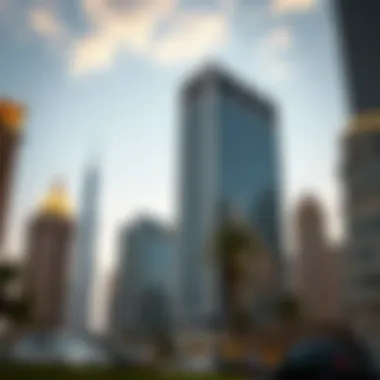

The presence of iconic buildings extends beyond mere visual appeal; they also significantly influence local communities. These structures can act as catalysts for social and economic activity, contributing to the vitality of neighborhoods. For instance, the development of Dubai Marina has transformed the area into a vibrant hub for both residents and tourists alike. The marina not only offers aesthetic pleasure but also practical advantages such as waterfront dining, leisure activities, and active nightlife.
Local communities often feel a sense of pride in their iconic buildings. They serve as landmarks that define their neighborhoods. Schools and organizations may even plan field trips, emboldening educational initiatives that revolve around architecture, engineering, and cultural studies. Younger generations grow up with these landmarks as symbols of innovation and ambition.
However, this progress sometimes brings challenges. Gentrification can lead to higher living costs and alter the community fabric, pushing some residents out. It’s essential to balance development with the needs of the local population, ensuring that progress doesn’t come at the expense of heritage and local character.
Ultimately, to appreciate the full impact of Dubai’s landmark buildings, one must consider both the exceptional experiences they provide to visitors and their broader influence on local communities. These structures are not just the city’s skyline; they are woven into the very identity of Dubai and its people.
Comparison of Architectural Styles in Dubai
Dubai’s skyline has morphed dramatically over the years, showcasing a rich tapestry of architectural styles that speak volumes about its evolution and aspirations. The comparison of architectural styles in this vibrant city is vital, as it reflects not only the aesthetic choices of the time but also the influences, culture, and practical considerations that come into play in urban design. As Dubai positions itself as a global city, this blend of traditional and modern architecture offers insights into how the past and future intertwine, making it a fascinating topic for investors, buyers, agents, designers, and analysts alike.
Traditional vs. Contemporary Architecture
Dubai’s traditional architecture primarily draws from Islamic influences, characterized by vibrant mosaics and intricate designs, evident in older structures like the Sheikh Saeed Al Maktoum House. These builds often make use of wind towers, or barjeels, to promote natural ventilation—a clever adaptation to the region’s sweltering climate. Traditional architecture isn’t just a nod to aesthetic values; it embodies practical strategies for living in desert conditions, demonstrating a deep connection between form and function.
Conversely, the contemporary architecture dominating today’s skyline pushes boundaries—think Burj Khalifa and the Museum of the Future. These structures utilize cutting-edge technology and innovative materials, often prioritizing aesthetics and height. They symbolize Dubai's leap into a new era, with glass facades and smooth lines that capture the sunlight, creating stunning reflections and shadows in the rapidly shifting light of the desert sky.
"The juxtaposition of traditional and contemporary styles in Dubai tells a story of resilience and ambition, where each brick laid is a piece of the city’s ongoing narrative."
The contrasting elements between these styles remind one of a cultural dialogue. Traditional architecture often seeks to preserve and celebrate heritage, while contemporary designs emphasize progress and comfort. While one might reminisce about the bygone era’s craftsmanship, the other offers a glimpse into what lies ahead.
Global Influences on Local Design
When exploring global influences on local design, we find that Dubai stands at a crossroads of culture and innovation. The architectural styles seen in Dubai do not emerge in a vacuum. Instead, they reflect international trends and partnerships often shaped by foreign architects and companies collaborating with local talents. For instance, the sleek lines of the Burj Khalifa, designed by Adrian Smith of Skidmore, Owings & Merrill, are a testament to how global design philosophies can effortlessly blend with local flavor.
Another element to consider is the impact of geopolitics. Economic ties and cultural exchanges with regions like Europe and North America have ushered in various architectural trends. Buildings such as the Dubai Mall and the Jumeirah Beach Hotel showcase features adopted from Western styles, while still maintaining a unique Middle Eastern essence.
Furthermore, as Dubai continues to attract international investments, it becomes a melting pot of architectural influences. This cross-pollination leads to a diverse skyline that not only fulfills the needs of residents and tourists alike but also stands as a canvas illustrating Dubai's global ambition.
In summary, the comparison of architectural styles in Dubai reveals a city embracing its roots while unabashedly reaching for the stars. With its rich background in traditional designs contrasted with cutting-edge contemporary endeavors and a myriad of global influences, Dubai's landscape offers a fascinating study for anyone interested in architecture, real estate trends, and cultural narratives.
The Interplay of Technology and Architecture
In recent years, the intersection of technology and architecture has emerged as a focal point in the advancement of urban landscapes. This interplay does not just enhance the aesthetic appeal of structures; it fundamentally reshapes how we interact with space. In a city like Dubai, where innovation and ambition are key drivers, this relationship becomes particularly significant. This section explores the various dimensions of this dynamic, especially focusing on smart buildings and the latest trends that are poised to define the future of real estate.
Smart Buildings and Urban Tech
Smart buildings are not merely a trend; they represent the pinnacle of modern architectural practice. These structures often integrate a wide array of technologies to optimize functionality, sustainability, and comfort. Imagine a high-rise that can sense the number of occupants in a room and adjust lighting or temperature accordingly. Technologies such as Internet of Things (IoT), artificial intelligence (AI), and energy management systems are at the forefront of this innovation.
The benefits of intelligent buildings are manifold:
- Energy Efficiency: Smart technologies allow for real-time energy consumption tracking. This results in lower energy costs and diminishes the overall carbon footprint.
- Enhanced Security: Features such as biometric access controls and advanced surveillance systems make buildings safer.
- Improved User Experience: Customizable environment settings ensure that residents or workers can tailor their space to meet personal comfort needs.
In Dubai, several smart buildings showcase this evolution. For instance, the Dubai Internet City employs cutting-edge tech to create a digitally connected environment that enhances both business and social interactions.
Future Technological Trends in Real Estate
Looking ahead, the real estate sector in Dubai is on the brink of groundbreaking innovations that promise to redefine urban living. Trends such as augmented reality (AR) for virtual property tours or blockchain for secure transactions are beginning to gain traction. These advancements could not only streamline processes but also improve transparency and trust in real estate dealings.
Furthermore, sustainable technologies, including solar panels and green roofs, are becoming indispensable in new developments. Addressing climate concerns is now seen as a critical element in the planning phase, impacting everything from design to construction materials.
To summarize, the dialogue between technology and architecture is crucial in shaping Dubai’s skyline and its urban environment. As we move forward, it will be fascinating to witness how these advancements not only enhance the functionality of buildings but also create a more connected and sustainable city.
"The buildings of tomorrow will not just stand as mere structures but as reflections of our technological era, entwined with the very fabric of our lives."
For more insights on smart buildings and architectural innovations, visit sources like Wikipedia or look at industry-related updates on Reddit.
Understanding the Market Dynamics of Landmark Properties
In the ever-evolving real estate market of Dubai, grasping the dynamics surrounding landmark properties is more than just a useful endeavor; it is essential. These structures, towering and iconic, play a significant role in shaping not just the skyline but the very economic backdrop of the city. Understanding this interplay among architecture, market trends, and socio-economic factors is vital for investors, buyers, agents, and designers alike. It isn't just about bricks and mortar; it's about how these buildings encapsulate the spirit of the times and attract opportunities.
Landmark buildings in Dubai do not merely serve functional purposes; they become symbols of investment, development, and pride. For example, the Burj Khalifa, as the tallest building in the world, isn't just an architectural feat; it acts as a significant magnet for tourism, foreign investment, and local commercial activities.
As the city gears up for the World Expo and further international events, understanding the pulse of this dynamic is crucial. Insights into market trends and predictions enable stakeholders to make informed decisions that can lead to substantial returns.
Investment Trends and Predictions
The real estate market in Dubai has witnessed cyclical fluctuations influenced by global and local economic conditions. Recent years have seen a resurgence in property investments as the city re-establishes itself as a hub for commerce and tourism. Tech innovations and an influx of expatriates continue to fuel demand in various property segments, particularly in prime locations.
- Residential Properties: Continuous growth in population drives the need for housing, leading to predictions that prices will stabilize and appreciate in the coming years.
- Commercial Properties: As multinational corporations set up offices in the city, there is an increasing appetite for commercial rentals, especially in iconic buildings that signify prestige.
- Luxury Market: The luxury segment continues to perform well, driven by high-net-worth individuals seeking exclusive residences in landmark locations.
- Sustainable Investments: There is a noticeable shift towards investing in eco-friendly buildings, which are increasingly favored by investors concerned about sustainability and environmental impact.
Despite the dynamic nature of these investments, potential buyers must remain vigilant of economic indicators and global market shifts which could affect demand and pricing.
Regulatory Changes Impacting Investments
The regulatory landscape in Dubai has undergone significant transformations to attract foreign investments and enhance market confidence. Understanding these changing regulations is no small feat, but it is paramount for any stakeholder navigating the environment of landmark property investments.
- Foreign Ownership Laws: Revisions to foreign ownership laws remain a critical highlight. Non-residents may have more opportunities to invest 100% in designated areas, making it far easier for foreigners to enter the market.
- Vision 2040: Under Dubai's Vision 2040, initiatives are directed towards sustainable urban planning that will impact future development projects, creating a different playing field for investment.
- Taxation and Fees: Keeping abreast of shifts in property taxation and fees, particularly those that encourage or discourage specific investment types, is crucial. The aim should always be to maximize returns while minimizing unnecessary expenses.
"In the world of real estate, knowledge is power; knowing the regulatory landscape can often be the difference between profit and loss."
End: The Enduring Legacy of Dubai's Landmark Buildings
Dubai's skyline is a vivid testament to its rich history and ambitious future, with each landmark building echoing the aspirations of a city that has made leaps and bounds in a short time. This article has explored how these structures not only redefine the aesthetic of urban living but also symbolize the cultural and economic fabric of this Emirati jewel.
Reflections on Architectural Significance
The architectural significance of Dubai's buildings cannot be overstated. Each structure tells a story, merging innovative designs with local heritage and aspirations for the future. Whether it’s the sweeping curves of the Burj Al Arab or the futuristic lines of the Museum of the Future, these buildings showcase a blend of practical functionality and artistic vision. They challenge conventional designs, pushing the envelope of what is possible while maintaining a strong connection to both culture and identity.
- Cultural Identity: Buildings like the Dubai Frame serve as a tangible link between the past and future, illustrating the city's transformation from a humble trading port to a bustling metropolis.
- Architectural Trends: Local architects and designers draw inspiration from global trends while embedding local elements, creating a unique architectural language that resonates with both residents and visitors.
“In analyzing Dubai's famed structures, one sees not just buildings but milestones marking its rapid growth.”
The significance of these landmarks extends beyond mere appearances. They are integrated into the community, serving as public spaces and symbols of national pride, fostering a sense of belonging among residents.
Future Prospects for Dubai’s Urban Landscape
As we turn our gaze to the future, it's evident that Dubai’s ambition will continue to shape its urban landscape. The city is not resting on its laurels. With an eye toward sustainability and technological innovation, upcoming projects promise to redefine how urban environments function.
- Upcoming Projects: The launch of new developments, like the sustainable initiatives in Dubai Creek Harbour, indicate that the city is keen on creating eco-friendly urban spaces that balance luxury living with environmental considerations.
- Technological Integration: Advancements in smart building technology will likely further enhance the functionality of these new structures, creating spaces that are both intuitive to inhabit and efficient in resource use.
In summary, the future of Dubai's architectural landscape looks promising, driven by a commitment to innovation, sustainability, and a profound respect for its cultural roots. As the city strives to carve out its niche on the global stage, its landmarks will remain central to that narrative, embodying the spirit of a city that is both modern and timeless.


